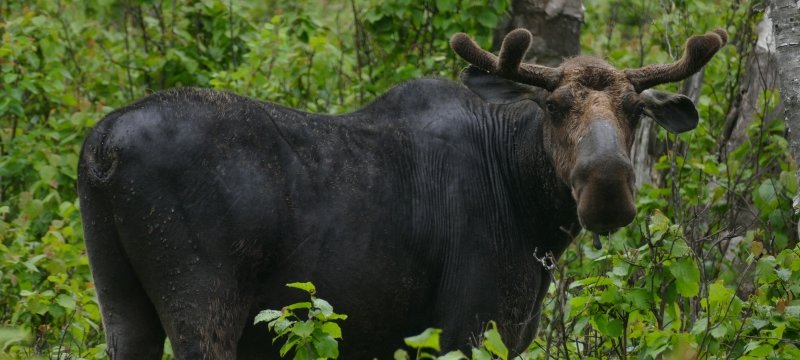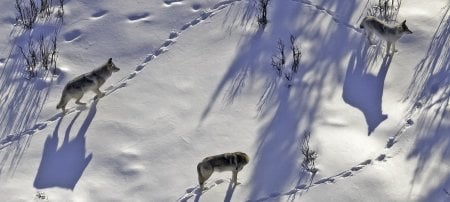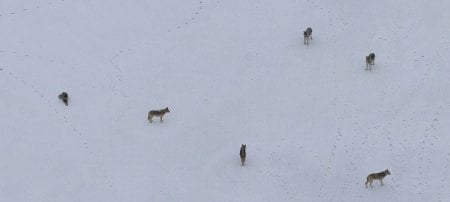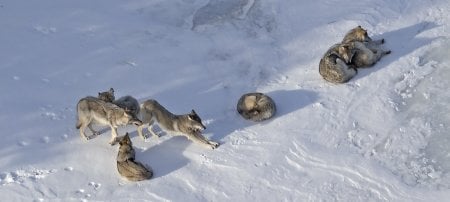Michigan Tech researchers return to the island to discover new insights about the wolves and moose of Isle Royale.
The COVID-19 pandemic halted the in-person wintertime survey of wolves and moose on the island for the first time in 63 years. Consequently, there are no estimates of wolf or moose abundance for 2021, and the next estimates are scheduled in February 2022. But though the Isle Royale Winter Study didn’t happen quite as planned, researchers were still able to visit the remote national park in the spring.
Now, fieldwork has resumed and Michigan Technological University researchers have already uncovered new information about these two iconic wildlife populations. In particular, wolves produced at least two litters of pups, and moose appear poised for decline.
In the Isle Royale Winter Study, Michigan Tech researchers share other significant developments about curating the world’s largest moose bone collection, advances in understanding of wolf foraging behavior and the nutritional health of the moose population.
The Isle Royale Wolf Population is Likely Growing
While population estimates are delayed, MTU’s research team gleaned enough clues to suggest that the Isle Royale wolf population is thriving.

The 2021 Winter Study details a growing wolf population, while the moose population shrinks. Moose bones, collected over decades, are catalogued, and warming winters play a role in moose nutrition.
“We recovered footage of a group of four wolf pups taken in January 2021 by remote cameras at the east end of Isle Royale,” said Sarah Hoy, research assistant professor in Michigan Tech’s College of Forest Resources and Environmental Science (CFRES). “Additionally, observations of tracks and scats left by wolf pups last fall at two different locations suggest that there were probably two different litters of pups living at the east end of the island in September 2020.”
There may also have been another litter born at the west end of the island last year. With reproduction figures like that, Hoy and colleagues expect the wolf population to have grown slightly or moderately since the last survey count, so long as there hasn’t been an unusually high death rate.
Michigan Tech researchers are currently working with the U.S. National Park Service and other research collaborators to discern death rates and the number of litters produced.
Mark Romanski, biologist and natural resources program manager at Isle Royale National Park, said the National Park Service will use the information collected by MTU researchers, along with information derived from genetic analyses conducted through Kristin Brzeski’s conservation genetics lab at Michigan Tech and in collaboration with Jerrold Belant at the State University of New York using remote cameras, to provide a formal wolf population estimate.
“We anticipate completing an initial summary of these data in July,” Romanski said. “Because of constraints placed on field activities during the pandemic, we are especially pleased to have multiple lines of evidence to enumerate the population.”
Wolves Are Specialized Foragers
Wolf scientists have long known that wolves are selective when it comes to their prey, preferring easier pickings: the young, the old and the infirm. What has not been known is whether that general tendency varies over time.
"Wolves tackle prey, like moose, that are 10 times their own body size with their teeth, which are only two inches long."
“It’s a daunting task, as there is a risk that wolves will be seriously injured or even killed by their 900-pound prey. So, it’s no surprise that wolves tend to prey on moose calves that are smaller and a bit less savvy than adults or on older moose that are in poorer health,” Hoy said.
But the proportion of calves or elderly moose in the overall population changes from year to year. MTU researchers wanted to know what wolves do when more vulnerable prey is relatively scarce.
Wolves face a choice: Keep searching for easy but rare prey, or attack the more abundant, healthier moose to save time spent looking for food, which comes with the increased risk of being seriously injured or killed. Turns out wolves prefer less risk — and not just on Isle Royale.
Hoy says classic foraging theory suggests that if predators want more food, they focus on whatever food is most widely available at the time.
“However, we found that wolves do not much exhibit that kind of flexibility,” she said. “Wolf foraging behavior seems driven by minimizing the risks associated with killing large prey, like moose, even when the differences in vulnerability among individual moose might seem relatively subtle compared to when predators are choosing between different prey species.”
Doug Smith of the U.S. National Park Service, who spearheaded the reintroduction of wolves in Yellowstone National Park, and Dan MacNulty of Utah State University, contributed to the report with research that suggests Yellowstone wolves also continue to seek out more vulnerable calves and elderly prey even if it means going hungry for longer stretches.
“We’ve long known that wolf and moose abundances on Isle Royale exhibit pronounced fluctuations over time,” said John Vucetich, CFRES distinguished professor of ecology at Michigan Tech. “Now we know that an important contributor to those fluctuations are these dynamic foraging preferences for weaker prey.”
Nutritional Stress Stacks the Deck Against Moose
When individuals of a population are in good nutritional condition, they are more likely to survive the year and successfully reproduce. Consequently, understanding the fluctuations in the abundance of a population depends greatly on knowing the nutritional condition of the individuals.
In a good year for moose on Isle Royale, less than 5% of the moose population is in very poor nutritional condition and starving; in a bad year, almost 25% of moose are starving. This observation led researchers to wonder what factors cause the nutritional health of moose to fluctuate so much from each year.
In much the same way that doctors use human urine to identify or rule out certain health issues, MTU researchers combed through three decades worth of data from moose urine samples. Moose urine contains certain metabolites that provide important clues about an individual’s health.
Researchers analyzed that data to see how the nutritional condition of moose changed with weather, competition for food and the likelihood of being killed by wolves. The analysis revealed that two-thirds of variation in moose nutritional condition from one year to the next is related to the weather.
“We found that the nutritional health of moose was importantly influenced by how hot it is during the summer, and also by how deep the snow is in winter,” Hoy said. “Moose tended to be more nutritionally stressed during winters with deep snow, which may be because deeper snow makes it more difficult for moose to move around and find food.”
Moose also tend to be more nutritionally stressed following a hot summer. Moose can become heat-stressed during hot summers. In response, they start to reduce the amount of food they eat and increase the time spent in thermal refuges, such as in conifer stands.
Additionally, balsam fir, the preferred food of Isle Royale moose, does not grow as well in warm climates. Therefore, after a hot summer there may be less high-quality food available to moose, which could also impact the overall nutritional health of the moose population.
“This research has important implications for understanding how moose are likely to cope with a warming climate,” Hoy said.
The Isle Royale Moose Population is Likely Declining
Since fieldwork resumed in spring 2021, MTU researchers have made several key observations about the island’s moose.
“Moose really struggled to find enough food this past winter,” Hoy said. “Because there have been such large numbers of moose on the island over the last five years and moose ate branches faster than the trees can recover and replace them, the amount of food available to moose during winter has been getting progressively worse each year since 2017.
"Balsam fir saplings, the main winter food source for moose, are in the worst condition ever observed during the 17 years that we’ve been monitoring them."
During spring vegetation surveys, researchers found that most balsam fir saplings had been browsed so severely that they had either been killed or left with only a few green branches at the west end of the island. Researchers also found the bodies of 13 moose, when in a regular year they would typically find only one to two starved moose.
Ticks Cause Moose to Scratch Off Their Winter Coats
Winter ticks are also worse than usual this year, as evidenced by moose with very little fur left in spring — having scratched or bitten off almost all of their winter coats in an effort to rid themselves of the blood-sucking parasites. This is significant because blood loss to ticks can exacerbate the detrimental effects of food shortage. Despite the mild winter, depleted food supplies and ticks made life harder for the island’s moose this year.

In this image from April 2021, an emaciated and nutritionally stressed bull moose — who is also severely impacted by winter ticks — beds down on the island. Image Credit: Sarah Hoy
The impact of wolves on moose over the last year remains unknown, but researchers continue to recover the remains of moose killed by wolves. Learning the full extent of wolf predation on moose will also wait until 2022’s winter field season.
The World’s Largest Catalog of Moose Bones
In addition to the research into wolves’ preferred prey and moose nutrition, the researchers also collaborated with the National Park Service to modernize the curation of thousands of moose bones, including a large share collected over decades by citizen scientists known as Moose Watch volunteers.
The world’s largest collection of moose bones will be further cleaned, photo-documented and put into a nationwide database of National Park Service biological artifacts at a facility with climate control and fire protection.
“It is gratifying to see the National Park Service invest in the long-term preservation of moose bones, and it is almost certain that the scientific value of the collection will increase over time,” said Rolf Peterson, CFRES research professor. “We have already put it to use in ways never anticipated when the bones were first collected and saved.”
The National Park Service provided personnel to develop plans to modernize the curation of moose bones and for a state-of-the-art, multi-park museum storage facility that will eventually house the bone collection. The National Park Service also provides vital funding to support the Michigan Tech students who clean and re-catalog the specimens, and to purchase the supplies and materials they need.
Despite the missed winter research on Isle Royale because of the pandemic, Michigan Tech’s wolf and moose researchers turned adversity into opportunity, providing further insight for the longest-running predator-prey study in the world.
Michigan Technological University is an R1 public research university founded in 1885 in Houghton, and is home to nearly 7,500 students from more than 60 countries around the world. Consistently ranked among the best universities in the country for return on investment, Michigan's flagship technological university offers more than 120 undergraduate and graduate degree programs in science and technology, engineering, computing, forestry, business, health professions, humanities, mathematics, social sciences, and the arts. The rural campus is situated just miles from Lake Superior in Michigan's Upper Peninsula, offering year-round opportunities for outdoor adventure.






Comments